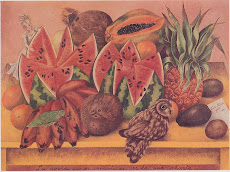In writing about geographies of food, animals cannot but be present. After all, animals provide the basic elements comprising so many human meals - here I mean non-human animals, although occasionally of course human animals have been food for other humans, and the geographies to be written, empirically and conceptually, of cannibalism might cause us pause for thought. (Incidentally, while musing on outlandish topics, recall the papers on the geography of geophagy [?] or 'earth-eating': there was definitely one on this topic in the 'Geographical Review', I think, back in the early-1970s.[Hunter 1973?])
But back to animals: yes, surely a geography of food must address the whole issue of the lifeforms that are the basis of so much that humans eat. There is a link to plant geography (biogeography), of course, but if we stick to animals, then subjects for discussion include obvious ones: the kinds of agricultural production systems into which animals are inserted, opening out on to the whole history of animal domestication (Kay Anderson's work [e.g. Anderson 1997, 1998?]), but maybe slightly inflecting the usual things to be said about the political-economies of such production systems - or indeed the cultural economies (Emma Roe's recent work? [2006a&b?]) - by worrying about the lifeworlds, experience, abuses, etc. of the animals themselves (see Michael Watts's work on chickens [eg. chapter at close of the 'Animal Spaces' book [Watts 2000?]] - he once declared that he wanted to write the history of capitalism through the eyes of a chicken).
Another angle is to consider the whole issue of the spaces between 'us' and the animals that we eat: they tend to kept away from centres of population - the whole 'get the livestock animals out of the city' argument (see my 1995 paper on 'Animals and the city' in S&S) - and in particular, an obvious but key point, so much effort is made to put the whole killing apparatus of the slaughterhouse (the 'disassembly line', as one writer called it) in spaces, behind walls, that the rest of us cannot see. (Note that there is an impressive tiny sub-genre of witing on the historical geography of slaugherhouses: I can give references.) This development is sometimes roped together - by authors as diverse as Baudrillard and Giddens - in an account of how 'developed' societies increasingly strive to place their psychologically troubling experiences (death, illness, madness, etc.) in distant spaces, often indexed as 'beyond the city' (and note here the links between cemetaries, asylums, prisons and slaughterhouses: often banished, from Victorian times onwards, to the most dubious, insalubrious outer districts of big cities - see Daniel Pick's [1993?] work on Parisian slaughterhouses). Surely, there is something key to consider for the geography of food - it has probably already been done somewhere, and maybe you have already commented upon it, if so apologies.
There is much else that could be said here about food geographies meeting animal geographies - but another twist might be to remember than non-human animals eat stuff too, and we humans will tend to call this 'food' - this point suggests two things: (i) what happens if we do a post-human geography of food, wherein food is everywhere for every being, etc. (does this just become 'ecology' by another name?); and (ii) what, culturally, is at stake in labelling something as 'food' (something that potentially can be eaten, by what?, and if we radically relativise what we mean by 'food', what it is, what can be eaten, what can eat it, when, where, with humans involved or maybe not, then what does a 'food geography' end up looking like?
[references guessed by Ian and added]
Sunday, September 7, 2008
Subscribe to:
Post Comments (Atom)

No comments:
Post a Comment